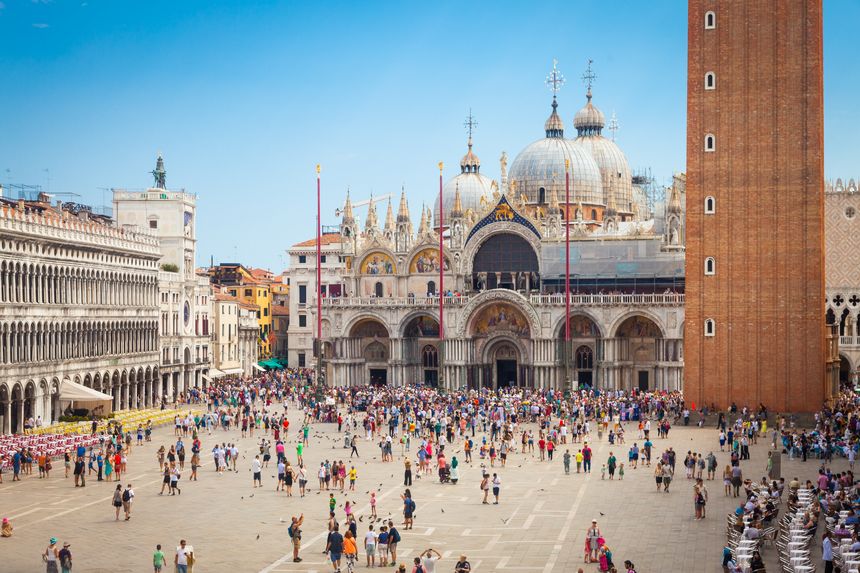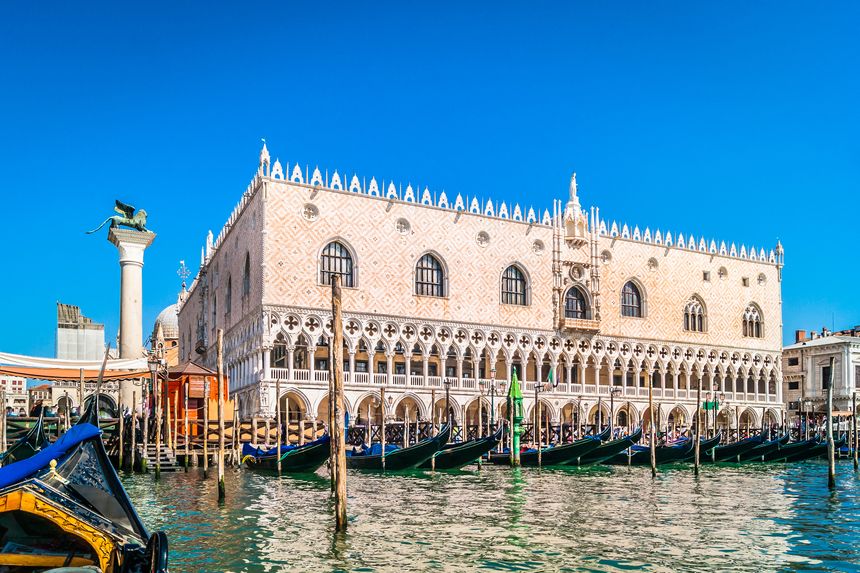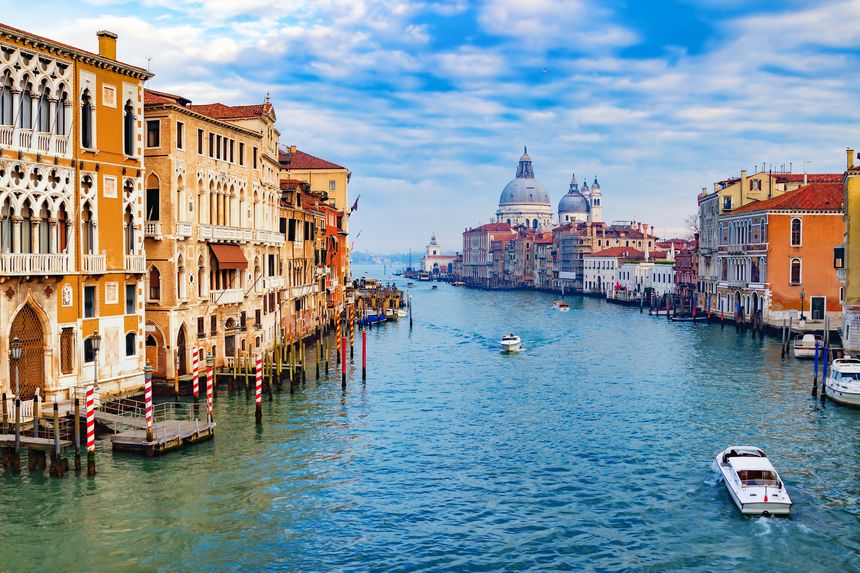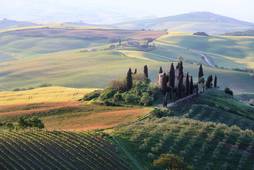Venise: 9 must-see attractions
Tourist attractions
What is there to see in Venice?

Piazza San Marco (St. Mark's Square)
Unmissable and one-of-a-kind (in Venice all squares are known as 'campi', only St. Mark is a piazza), this mythical place was the seat of economic, political and religious power and is home to the most prestigious buildings in the city, including St. Mark's Basilica , Doge's Palace, the New and Old Procuratie, the Napoleonic wing, recognisable by its endless archways, and not to mention the Clock Tower and the Piazzetta columns ...
Just climb to the top of the Campanile to take in the spectacular theatrical setting, and before leaving make sure to stop in one of the historic cafés, even if it is very expensive. Because this is an ideal spot to really take in the atmosphere: the Florian cafe, founded in 1720 and frequented by Carlo Goldoni or Giacomo Casanova, and the Quadri cafe, inaugurated some fifty years later and frequented by the creme de la creme of 19th century authors.
Monuments | Art & Culture | Architecture

Basilica di San Marco (Saint Mark's Basilica)
Standing in front of the 11th century basilica, home to the relics brought back by Saint Mark from Alexandria in 828 , you almost feel like you're in a scene from 'One Thousand and One Nights'. The five domes, the gold and marble facades already evoke the splendors of the East ... which is then enhanced by the 4,000 m2 of interior gold-coloured mosaics (11th-14th century) which depict a gigantic illustrated bible.
With their geometric patterns and animal figures, the walkways could compete with the finest Oriental rugs while the Pala d'Oro, a golden altarpiece of the 10th-14th century and a Byzantine craftsmen masterpiece, shines brightly with its 2,000 precious stones and 250 cloisonné enamels. The treasure (le Tesoro), too, has oriental influences as it brings together objects that arrived in Venice after the sack of Constantinople, the capital of the Byzantine Empire, in 1204. And even the bronze horses of St. Mark, which adorned the Hippodrome of Constantinople, represent the Crusaders spoils of war!
Monuments | Art & Culture | Architecture | Museums

Palazzo Ducale (Doge's Palace)
This very elegant pink marble and lace-like stone palace was originally just a massive wooden castle that went up in flames! It was not until the 14th century, that it became the "House of the Doges" - those who governed the Serenissima for nearly 1,000 years - and was rebuilt in a Gothic style, benefitting from an exceptional decorative programme which included frescoes celebrating the Serenissima, its sea and land conquests and institutions.
The tour begins on the second floor, which is reached by the Scala d'Oro. This staircase leads to the Doge apartments and a maze of rooms that testify to the mysteries of Venetian power. You then reach the Grand Council hall, which hosted meetings of the supreme magistracy: it is adorned with an impressive painting by the artist Tintoretto, Le Paradis (7m x 22m).
You then disappear down into the infamous Prisons, across the Bridge of Sighs, so-called because of the sighs prisoners would heave at their final view of beautiful Venice through the window before being taken down to their cells. A service staircase connects the pozzi (well) on the ground floor to the piombi (sinks), located under the roofs, where the famous Casanova was locked away! After the inner court and its Scala dei Giganti, where the Doge was enthroned, you leave the palace by the entrance of honor crossing the portico Foscari and Porta della Carta, guarded by the winged lion sculpture, a symbol of Saint Mark and Venice.
Monuments | Art & Culture | Architecture | Museums

Rialto
This is the oldest district of Venice: the small village of Rivoaltus (high bank) is mentioned as early as the 9th century. It became Rialto two centuries later, and from then on the heart of the city's commercial life. Here you will find wholesale and retail markets, Eastern spice and silk shops and the tax administration, agencies responsible for regulating trades and corporations ... Today, it is still the headquarters of Venice's main market .
The white stone bridge , which is probably as famous as the Bridge of Sighs, replaced several successive wooden structures at the end of the sixteenth century, which couldn't take the weight of the crowds or the fires which ravaged them during the Serenissima reign. The architect, aptly named Antonio da Ponte, designed this bridge in the form of circumflex accent, high enough (7.50 m) to allow the passage of tall ships, including the very famous Bucintoro, a highly decorated galley used by the doge. There's a lovely view of the Grand Canal from the bridge.
To live like a Venetian (and incidentally to escape the crowds), get up early to walk around the market alleys on the docks around the bridge: the Erberia (fruit and vegetables) market and the Pescheria market (fish). You'll also have the opportunity to see the small lagoon boats (topi and bragozzi) who come to deliver their food, such as small purple artichokes and peppers from the island of Sant'Erasmo.
Monuments | Art & Culture | Architecture | Museums

The Peggy Guggenheim Collection
Contemporary art lovers, here's a little bit of heaven! The Guggenheim is one of the most important Italian museums for European and American art from the early part of the twentieth century. Located on the edge of the Grand Canal, the Venier dei Leoni palace delights passers by with its immaculate whiteness but also because it is unfinished; its construction was stopped after the first tranche of works! A unique site on the Grand Canal. The palace, built in the eighteenth century for the powerful Venier family, is known to have belonged to the eccentric American aesthete Peggy Guggenheim, who set up her formidable collection of modern art in the 1950s, a collection focussed on surrealism (with works by Magritte, Klee, Dalí ...) and American abstract expressionism - the gallery owner spotted early on works by Kooning, Rothko and Pollock.
A year after Peggy's death in 1979, the Solomon R. Guggenheim Foundation, the property's heiress, opened the Collezione Peggy Guggenheim and continues to add to it. In 2012, Hannelore and Rudolph Schulhof bequeathed a part of their collection to the museum: 80 post-war works of Italian, European and American origin (Burri, Kiefer, Dubuffet, Calder ...) now adorn the collection! A visit here is concluded by a pleasant visit to the garden, where there is a selection of sculptures on show (Giacometti, Arp, Marini, Kapoor ...).
Monuments | Art & Culture | Architecture | Museums

L’Accademia
The huge Gallerie dell'Accademia complex occupies the old Scuola Grande di Santa Maria della Carità, one of the city's oldest brotherhoods (thirteenth century), the Santa Maria church and the Convent of the Lateran Canons. Since 1817, the public has been able to view the finest Venetian paintings. From primitive to Renaissance artists, not forgetting the Settecento artists [from the eighteenth century], paintings from all the great masters are on show: Paolo Veneziano, Giovanni Bellini, Gentile Bellini, Carpaccio, Titian, Veronese, Tintoretto, Tiepolo or Longhi ... It must be said that the City of Doges attracted many artists between the fourteenth and eighteenth century, because institutions and wealthy patricians insisted on illustrating their glory and success left, right and centre. Over time, and and following multiple donations, the exhibition spaces have grown. Major upgrading work has been underway since 2005; they should be completed by 2020 ...
Monuments | Art & Culture | Architecture | Museums

The Grand Canal
Venice is often compared to a fish, with the tail being the sestiere of Castello, the head, Cannaregio, and its long body, the Grand Canal. The latter actually splits the city in two (3 sestieri on one side of the canal, three on the other side) and draws a large inverted 4km-long S shape. This waterway, whose width can reach 70 m, is lined with palaces (there are more than 200 built by the great patrician families) and churches (fifteen or so).
The Grand Canal can only be crossed on foot in four places, thanks to the Costituzione (Piazzale Roma), Scalzi (in front of the station), Rialto and Accademia bridges. But it can also be crossed for a small fee by traghetti, collective gondolas where you travel standing up with the locals. The best way to enjoy the show (and the most economical) is to take line 1 of the vaporetto from the station to Saint Mark's Square. Some important buildings: the Ca 'Vendramin Calergi , where Richard Wagner died, the Baroque Ca' Pesaro palace with its diamond-pointed facades, the delicate Ca 'd'Oro', which echoes the Gothic architecture of the Doge palace, the Ca 'Foscari , in the curve of the Canal, a privileged position, the Ca 'Rezzonico' , seat of the 18th century museum, facing Palazzo Grassi , the last of the grand palaces built on the Grand Canal, and finally the truncated Venier dei Leoni palace.
As well as these majestic palaces, there are numerous warehouses, dating back to the time when Venice welcomed merchants and traders from all over the world: Veneto-Byzantine in style, the Fondaco dei Turchi, [warehouse of the Turks], is now a Museum, while the 13th century Fondaco dei Tedeschi [warehouse of the Germans], rebuilt in 1508, is now home to a luxury shopping centre.
Monuments | Art & Culture | Architecture | Museums

Basilica di Santi Giovanni e Paolo
The mendicant orders left behind two great Gothic sanctuaries in Venice: the Frari, in the San Polo district, a Franciscan sanctuary, and Santi Giovanni Paolo, in the Castello area, built by thirteenth and fifteenth-century Dominicans. They certainly try to outdo each other in terms of size and artistic richness, both assuming the title of the "Pantheon" of Venice. Behind it's large and somewhat plain façade, made from pink bricks hemmed with white, it opens onto a huge basilica more than 100 m long and 32 m high.. Santi Giovanni e Paolo (or San Zanipolo in Venetian dialect) is home to at least 25 doge tombs, as well as Venetian monuments from some of the greatest statue grand masters, such as the Tommaso Mocenigo and Sebastiano Venier monuments.
The church also preserves the most important Venetian collection of Veronese artefacts in the Rosary chapel (to the left of the main altar) and some Italian masterpiece paintings: The Saint Vincent Ferrer Altarpiece, by Giovanni Bellini (second altar on the right), The Alms of Saint Anthony (1542) by Lorenzo Lotto (to the right of the choir).
Monuments | Art & Culture | Architecture | Museums

Scuola San Giorgio degli Schiavoni
This absolute gem is generally not considered a must-see attraction, yet it's our absolute favourite! At a bend in an alley, behind a white facade, hides a "minor" brotherhood adorned with a dazzling display of Carpaccio paintings, founded in 1451 by Dalmation sailors, artisans and shipowners that settled in Venice, At the beginning of the 16th century, the brotherhood received a very precious gift from the patriarch of Jerusalem: the relics of their patron saint, Saint George. The interior decoration is dominated by Carpaccio paintings. At the height of his career, between 1502 and 1507, the painter completed nine paintings on the lives of the Dalmation's three patron saints; Saint George, Saint Trifon and Saint Jerome, showcasing his talent as a narrator.
Undeniably, the most famous painting is that of Saint-George slaying the dragon: a handsome blonde-haired knight rushes forth, throwing himself towards a scary dragon to save the daughter of the king who had been chosen by the city's people to be sacrificed. The painting's surrounding landscape, despite the beautiful palaces, is somewhat macabre with skulls and human remains strewn across the ground, in strong contrast with the following episode, The Triumph of Saint-Georges, in which the saint finishes off the dragon in a shimmering setting with oriental accents (note the sharpness of the spectator's costumes). With his Vision of St. Augustine painting, Carpaccio is fully in keeping with the era: he carefully reproduces the office of a cultured and refined humanist of the time, a personnage passionate about reading, astronomy, sculpture and music.
Monuments | Art & Culture | Architecture | Museums
You may also like
-
Flights to Venice and surroundings
All you need to know before buying your plane ticket
-
Tourist maps
Region, attractions and distance map Venice and surroundings!
-
Hotel or vacation rental?
Find your dream accommodation in Venice and surroundings at the best price...
-
When to go?
Be sure to visit Venice and surroundings at the best time of year!
and why not...
 Tuscany
Tuscany




